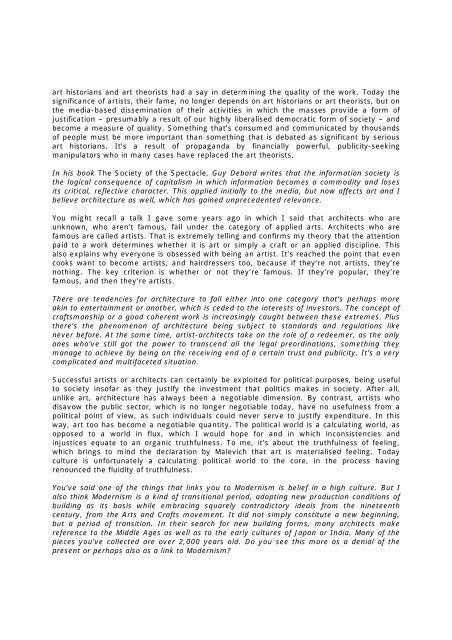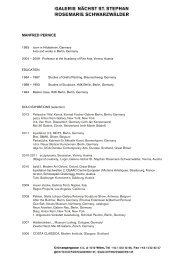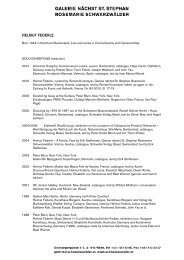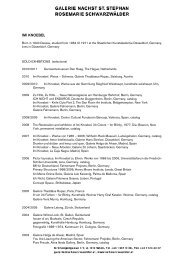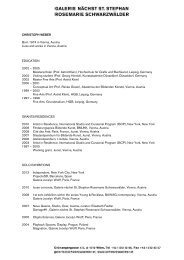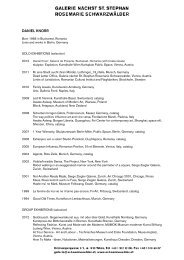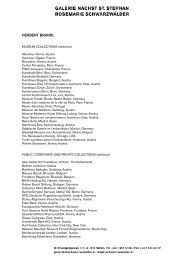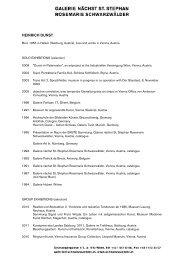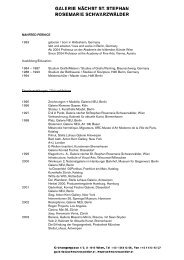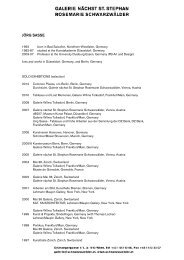Helmut Federle in conversation with Christian Kerez
Helmut Federle in conversation with Christian Kerez
Helmut Federle in conversation with Christian Kerez
Create successful ePaper yourself
Turn your PDF publications into a flip-book with our unique Google optimized e-Paper software.
art historians and art theorists had a say <strong>in</strong> determ<strong>in</strong><strong>in</strong>g the quality of the work. Today the<br />
significance of artists, their fame, no longer depends on art historians or art theorists, but on<br />
the media-based dissem<strong>in</strong>ation of their activities <strong>in</strong> which the masses provide a form of<br />
justification – presumably a result of our highly liberalised democratic form of society – and<br />
become a measure of quality. Someth<strong>in</strong>g that’s consumed and communicated by thousands<br />
of people must be more important than someth<strong>in</strong>g that is debated as significant by serious<br />
art historians. It’s a result of propaganda by f<strong>in</strong>ancially powerful, publicity-seek<strong>in</strong>g<br />
manipulators who <strong>in</strong> many cases have replaced the art theorists.<br />
In his book The Society of the Spectacle, Guy Debord writes that the <strong>in</strong>formation society is<br />
the logical consequence of capitalism <strong>in</strong> which <strong>in</strong>formation becomes a commodity and loses<br />
its critical, reflective character. This applied <strong>in</strong>itially to the media, but now affects art and I<br />
believe architecture as well, which has ga<strong>in</strong>ed unprecedented relevance.<br />
You might recall a talk I gave some years ago <strong>in</strong> which I said that architects who are<br />
unknown, who aren’t famous, fall under the category of applied arts. Architects who are<br />
famous are called artists. That is extremely tell<strong>in</strong>g and confirms my theory that the attention<br />
paid to a work determ<strong>in</strong>es whether it is art or simply a craft or an applied discipl<strong>in</strong>e. This<br />
also expla<strong>in</strong>s why everyone is obsessed <strong>with</strong> be<strong>in</strong>g an artist. It’s reached the po<strong>in</strong>t that even<br />
cooks want to become artists, and hairdressers too, because if they’re not artists, they’re<br />
noth<strong>in</strong>g. The key criterion is whether or not they’re famous. If they’re popular, they’re<br />
famous, and then they’re artists.<br />
There are tendencies for architecture to fall either <strong>in</strong>to one category that’s perhaps more<br />
ak<strong>in</strong> to enterta<strong>in</strong>ment or another, which is ceded to the <strong>in</strong>terests of <strong>in</strong>vestors. The concept of<br />
craftsmanship or a good coherent work is <strong>in</strong>creas<strong>in</strong>gly caught between these extremes. Plus<br />
there’s the phenomenon of architecture be<strong>in</strong>g subject to standards and regulations like<br />
never before. At the same time, artist-architects take on the role of a redeemer, as the only<br />
ones who’ve still got the power to transcend all the legal preord<strong>in</strong>ations, someth<strong>in</strong>g they<br />
manage to achieve by be<strong>in</strong>g on the receiv<strong>in</strong>g end of a certa<strong>in</strong> trust and publicity. It’s a very<br />
complicated and multifaceted situation.<br />
Successful artists or architects can certa<strong>in</strong>ly be exploited for political purposes, be<strong>in</strong>g useful<br />
to society <strong>in</strong>sofar as they justify the <strong>in</strong>vestment that politics makes <strong>in</strong> society. After all,<br />
unlike art, architecture has always been a negotiable dimension. By contrast, artists who<br />
disavow the public sector, which is no longer negotiable today, have no usefulness from a<br />
political po<strong>in</strong>t of view, as such <strong>in</strong>dividuals could never serve to justify expenditure. In this<br />
way, art too has become a negotiable quantity. The political world is a calculat<strong>in</strong>g world, as<br />
opposed to a world <strong>in</strong> flux, which I would hope for and <strong>in</strong> which <strong>in</strong>consistencies and<br />
<strong>in</strong>justices equate to an organic truthfulness. To me, it’s about the truthfulness of feel<strong>in</strong>g,<br />
which br<strong>in</strong>gs to m<strong>in</strong>d the declaration by Malevich that art is materialised feel<strong>in</strong>g. Today<br />
culture is unfortunately a calculat<strong>in</strong>g political world to the core, <strong>in</strong> the process hav<strong>in</strong>g<br />
renounced the fluidity of truthfulness.<br />
You’ve said one of the th<strong>in</strong>gs that l<strong>in</strong>ks you to Modernism is belief <strong>in</strong> a high culture. But I<br />
also th<strong>in</strong>k Modernism is a k<strong>in</strong>d of transitional period, adopt<strong>in</strong>g new production conditions of<br />
build<strong>in</strong>g as its basis while embrac<strong>in</strong>g squarely contradictory ideals from the n<strong>in</strong>eteenth<br />
century, from the Arts and Crafts movement. It did not simply constitute a new beg<strong>in</strong>n<strong>in</strong>g,<br />
but a period of transition. In their search for new build<strong>in</strong>g forms, many architects make<br />
reference to the Middle Ages as well as to the early cultures of Japan or India. Many of the<br />
pieces you’ve collected are over 2,000 years old. Do you see this more as a denial of the<br />
present or perhaps also as a l<strong>in</strong>k to Modernism?


